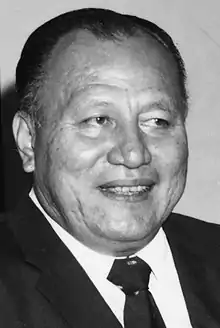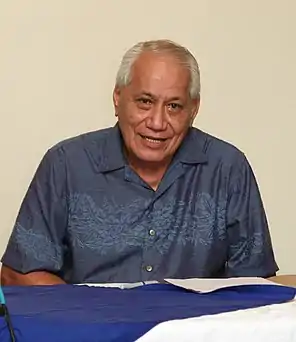Prime Minister of Samoa
The prime minister of Samoa is the head of government of the Independent State of Samoa, a sovereign country located in the Pacific Ocean.
| Prime Minister of the Independent State of Samoa Palemia o le Malo Tuto‘atasi o Sāmoa | |
|---|---|
 | |
 | |
| Style | The Honourable |
| Status | Head of Government |
| Abbreviation | PM |
| Member of | Legislative Assembly of Samoa, Cabinet of Samoa |
| Seat | Apia |
| Appointer | O le Ao o le Malo of Samoa (Head of State) |
| Term length | Five years, renewable indefinitely |
| Constituting instrument | Constitution of Samoa |
| Precursor | Leader of Government Business |
| Inaugural holder | Fiamē Matā'afa Fiame Mulinu'u II |
| Formation | 22 May 1875 (Prior to Colonisation) 1 October 1959 (Shortly before Independence) |
| Deputy | Deputy Prime Minister of Samoa (Office Vacant since 11 September 2020) |
| Salary | 78,000 USD annually[1] |
| Website | |
 |
|---|
| This article is part of a series on the politics and government of Samoa |
| Constitution |
History of the office
Colonial period
The first prime minister during the colonial period was Albert Barnes Steinberger, who originally represented the American government in the Samoan Islands but was close to German commercial interests. After the indigenous authorities of the islands adopted the Constitution of 1873, Steinberger was appointed Prime Minister by King Malietoa Laupepa in July 1875. He held this post for seven months before the British and American consuls in the country persuaded Laupepa to dismiss him, seeing his role as German interference in the islands. Over the next two decades, there was no prime minister in the country, and in 1899 Samoa fell under the colonial rule of the Western powers, being divided as a German colony and an American colony at the end of the Second Samoan Civil War, according to the terms of the Tripartite Convention.[2]
At the beginning of the World War I, German Samoa was occupied by New Zealand in 1914, and was subsequently organized as a trust territory of New Zealand in 1920.
Post-independence period
The territory gained independence in 1962 as the Independent State of Western Samoa. The Constitution, adopted in 1960 during the transitional period of autonomy, provides that the executive power is vested in the head of state (O le Ao o le Malo), elected by the Legislative Assembly, and who acts only on the recommendation of the government. The head of state has royal assent powers to sign bills into law and dissolve Parliament. Executive power is exercised by the prime minister and his cabinet. The prime minister is appointed by the head of state as a member of the Legislative Assembly who enjoys the confidence of a majority in the Legislative Assembly (Article 32 (2) (a)). The prime minister may be removed from office by the Legislative Assembly (Article 33 (1) (b)). Samoa is thus a parliamentary democracy based on the Westminster system.[3]
Prime Minister of the Kingdom of Samoa (1875-1876)
- Political Party
| No. | Portrait | Name (Birth–Death) |
Election | Term of office | Political party | Monarch | ||
|---|---|---|---|---|---|---|---|---|
| Took office | Left office | Time in office | ||||||
| 1 |  |
Albert Barnes Steinberger (1840–1894) |
— | 22 May 1875 | 8 February 1876 | 262 days | Independent | Laupepa |
| Post abolished (8 February 1876 – 1 October 1959) | ||||||||
List of Prime Ministers of the Independent State of Samoa (1959-Present)
- Political Parties
- Other Factions
- Symbols
† Died in office
| No. | Portrait | Name (Birth–Death) |
Election | Term of office | Political party | O le Ao o le Malo (Head of state) | ||
|---|---|---|---|---|---|---|---|---|
| Took office | Left office | Time in office | ||||||
| 1 | .jpg.webp) |
Mata'afa Mulinu'u II (1921–1975) |
1961 1964 1967 |
1 October 1959 | 25 February 1970 | 10 years, 147 days | Independent | Meaʻole Tanumafili II |
| 2 |  |
Tupua Tamasese Lealofi IV (1922–1983) |
1970 | 25 February 1970 | 20 March 1973 | 3 years, 23 days | Independent | Tanumafili II |
| (1) | .jpg.webp) |
Mata'afa Mulinu'u II (1921–1975) |
1973 | 20 March 1973 | 20 May 1975† | 2 years, 61 days | Independent | Tanumafili II |
| — |  |
Tupua Tamasese Lealofi IV (1922–1983) Acting |
— | 21 May 1975 | 24 March 1976 | 308 days | Independent | Tanumafili II |
| 3 |  |
Tui Atua Tupua Tamasese Tupuola Efi (1938–) |
1976 1979 1982 |
24 March 1976 | 13 April 1982 | 6 years, 20 days | Independent | Tanumafili II |
| 4 |  |
Va'ai Kolone (1911–2001) |
— | 13 April 1982 | 18 September 1982 | 158 days | HRPP | Tanumafili II |
| (3) |  |
Tui Atua Tupua Tamasese Efi (1938–) |
— | 18 September 1982 | 31 December 1982 | 104 days | Independent | Tanumafili II |
| 5 |  |
Tofilau Eti Alesana (1924–1999) |
1985 | 31 December 1982 | 30 December 1985 | 2 years, 364 days | HRPP | Tanumafili II |
| (4) |  |
Va'ai Kolone (1911–2001) |
1988 | 30 December 1985 | 8 April 1988 | 2 years, 100 days | HRPP | Tanumafili II |
| (5) |  |
Tofilau Eti Alesana (1924–1999) |
1991 1996 |
8 April 1988 | 23 November 1998 | 10 years, 229 days | HRPP | Tanumafili II |
| 6 |  |
Tuilaepa Aiono Sailele Malielegaoi (1945–) |
2001 2006 2011 2016 |
23 November 1998 | Incumbent | 22 years, 76 days | HRPP | Tanumafili II Tufuga Efi Va'aletoa Sualauvi II |
Timeline

Living former prime ministers
As of February 2021 there is only one former living Samoan prime minister, as seen below.
- Living former Prime Minister(s) of Samoa

See also
- Samoa
- Lists of incumbents
Notes
References
- Hill, Bruce (28 September 2016). "Samoan leaders salaries published by newspaper". ABC Radio Australia.
- Malama Meleisea, Lagaga: A Short History of Western Samoa, Apia, University of the South Pacific, 1987, ISBN 982-02-0029-6, pp.83-85
- Constitution of Samoa